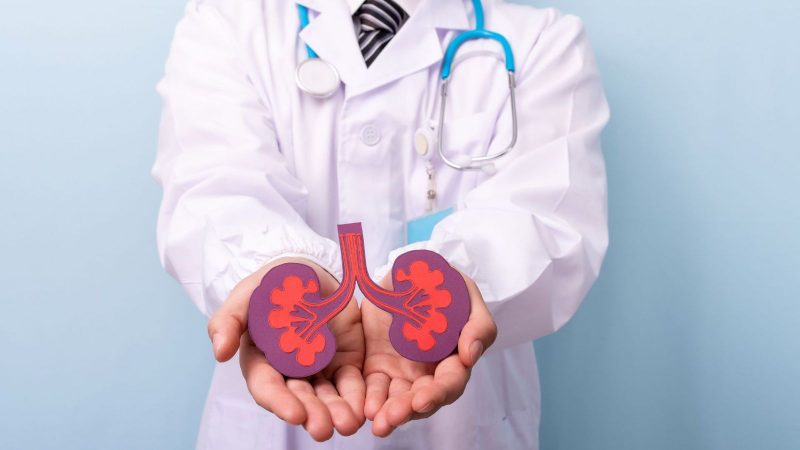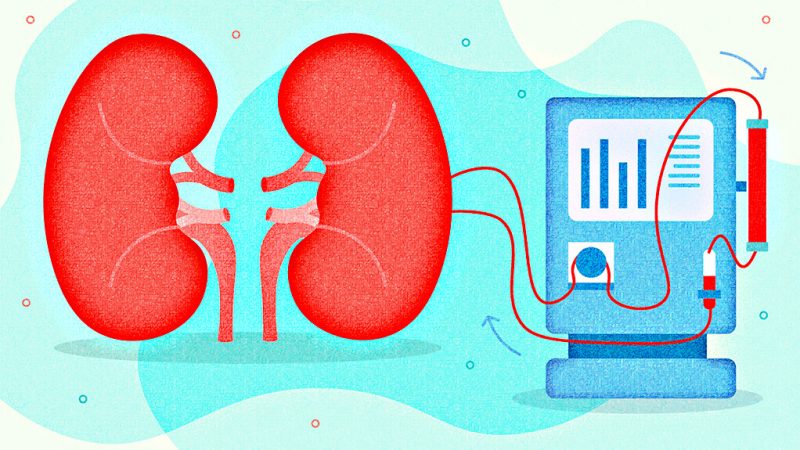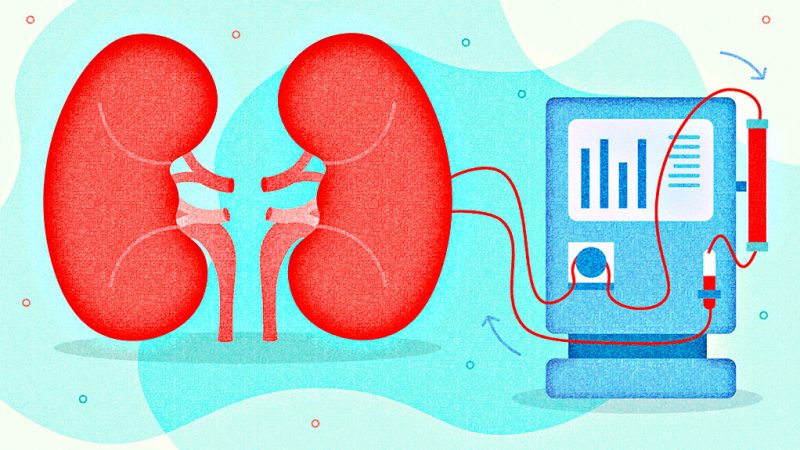All you need to know about Online Hemodiafiltration (OL-HDF)

ONLINE HAEMODIAFILTRATION (OL-HDF)
With main focus to better the shortened life expectancy and quality of life of patients with End-Stage Renal Disease (ESRD) who are sustained through dialysis, there are a number of modes of haemodialysis therapies that hospitals offer to patients according to their specific needs. The Centre of Renal Sciences at Yashoda Hospital & Research Centre is here to provide you quality treatment with the latest and best diagnostic and therapeutic facilities through our multidisciplinary specialists who consider patient-centric treatment as the best and most effective way to withstand End-Stage Renal Disease (ESRD). One of the best possible haemodialysis modes of treating ESRD that our specialist that offer is Online haemodiafiltration (OL-HDF).
What is Online haemodiafiltration (OL-HDF)?
Online haemodiafiltration (OL-HDF) refers to the combination of diffusion and convective solute transportation using high-flux membrane with an effective ultrafiltration rate of no less than 20% of the blood flow rate while using online-generated sterile and non-pyrogenic solution for fluid substitution. By far, this method has been proven to be most technologically advanced convective form of blood purification with the potential to improve results in ESRD patients. Our specialists at Yashoda Hospital & Research Centre, Nehru Nagar, Ghaziabad knowing that the technological prospects of OL-HDF have clinical advantages over standard conventional HD, use this technique effectively. The key mechanisms under which this mode of dialysis operates and the same reasons why this is recommended include:
- Sustained lower residual uremic syndrome,
- Reduced systemic inflammatory response due to the combined use of biocompatible membranes and sterile fluids, and
- In cases of intra-treatment hypotensive episodes, the multiple mechanisms with higher sodium mass transfer and mode-specific thermal effects work most effectively.
What are the different modes of Online Hemodiafiltration (OL-HDF)?
Besides the different modes of OL-HDF depending upon the site of replacement fluid infusion, 4 methods of OL-HDF are currently used across the world: post-dilution HDF, pre-dilution HDF, mixed-dilution HDF and mid-dilution HDF. After a thorough examination of your condition and the site of the required treatment in your body, our specialists will recommend them on the basis of the condition of the patient and centre specific characteristics. The distinctions in the methods are briefly stated below:
In post-dilution HDF, the haemo-concentration generally limits the rate of ultrafiltration to a filtration fraction of 20–30% of the blood flow rate due to the correction of renal anaemia and increased protein concentration which may lead to impaired removal of solutes.
In pre-dilution HDF, ultrafiltration rate is not limited by the blood flow rate which reduces the efficiency of both the diffusion and convective components of solute removal.
In mixed-dilution HDF, since substitution fluid is administered simultaneously with the combination of pre-dilution and post-dilution, the infusion ratio between the two and total infusion sum are both controlled, which results in significantly higher convective removal of small and middle molecular uraemic toxins.
In mid-dilution HDF, a high concentration gradient is first created for the efficient removal of small molecules by diffusion with maximal ultrafiltration of plasma water for efficient clearance of larger molecules by convection.
Criteria for selection of the mode of dialysis:
Although there are no contraindications of high volume OL-HDF, different cases of End-Stage Renal Disease (ESRD) with different risk factors and symptoms require varying modes of dialysis for the best results in patients. Taking this into account, our experts recommend the following criteria on the basis of which the modes of treatment are selected:
– Age indication: Children/adolescents or young age have higher tendency for long-term dialysis treatment.
– Persistent symptoms of uraemia which include dialysis-related amyloidosis, uraemic neuropathy such as restless legs syndrome and sleep disturbances, uraemic pruritus and skin hyperpigmentation.
– Intolerance of haemodialysis sessions may cause nausea, vomiting, cramps, headache, post dialysis fatigue, frequent symptomatic episodes of intradialytic hypotension.
– Some highly specific indications include specific diseases such as high blood viscosity, cryoglobulinaemia, gammopathies and high hematocrit; poor vascular access; slightly built body; and non-adherence observed in excessive interdialytic weight gain in patients unwilling to accept prolonged treatment sessions.
Benefits of Online haemodiafiltration (OL-HDF)
Benefits of the therapy: High volume OL-HDF is the most effective for elimination of middle molecules which decrease cardiovascular risk factors related to patients under dialysis. This therapy not only maintains Serum ß2-m and phosphate levels but also improves inflammatory response, ensures intradialytic haemodynamic stability and controls anaemia which altogether caters to the patients’ survival.
Reduction in mortality risk: Studies have shown that a good 30% risk reduction in mortality for patients with high-efficiency post-dilution OL-HDF is observed when compared to standard haemodialysis. Experts have also claimed that HDF reduces the risk of all-cause and cardiovascular mortality, especially with convection volumes of at least 23 L/session.
Cost-efficiency: Compared to various other methods of treatment, the overall cost of treatment is reduced in high volume HDF without compromising its efficiency. Additional benefits include its eco-friendliness factor which naturally reduces the treatment cost due to effective and sustainable use of resources.
Optimised use of resources: Since all the preparations for sterile, non-pyrogenic substitution fluid for High Volume HDF are based on a double-stage filtration process, there is no extra cost for additional single-use filter or ready-made rinse solutions or wastage of bags for priming and reinfusion which altogether optimise the use of resources utilised in the whole process.
Low hospitalisation rate: The amount of EPO and phosphate binders administered to patients during dialysis has been observed to reduce with the application of HDF. This allows higher quality of care to be provided at a lower medication burden and cost. Besides this, low hospitalisation rate always has a better impact on the patient’s quality of life.
Improved survival: Experts have observed that with High Volume HDF, there is a reduction in mortality from infection as well as stroke. Risk reduction in hypotensive episodes, as well as all-cause hospitalisation, improves the overall being of the patient.
Whom to consult?
Since high volume Online Haemodiafiltration (OL-HDF) therapy consists of several methods or modes of dialysis, treatments are highly specific and vary from one hospital or healthcare institution to another. A thorough examination of every ESRD patient’s case calls for highly personalised treatments and our specialists at the Centre of Renal Sciences at Yashoda Hospital & Research Centre are here to help you develop the best treatment plan as they monitor and regulate your dialysis treatment regularly.
For any query about End-Stage Renal Disease (ESRD) and Online Haemodiafiltration (OL-HDF), please feel free to reach out to us on our official website www.yashodahealthcare.com or book an appointment with our specialists Dr. Pradeep Prakash, Dr. Ravinder Singh Bhadoria, and Dr. Vaibhav Saxena by calling us on 09810922042.



